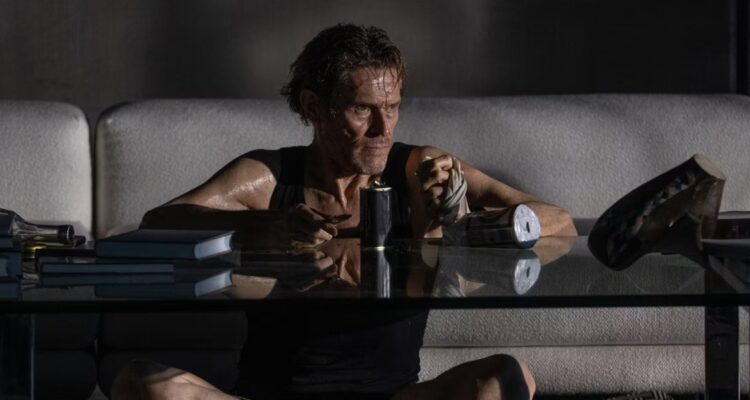Director Vasilis Katsoupis tells the audience exactly what “Inside” is about to do from its very first scene. The disembodied voice of Willem Dafoe narrates a childhood fable fished from the depths of memory. The story, a seemingly simple school ruse about the things a young kid would save from a burning house, highlights how art has always been the utmost priority in this man’s life — coming above it all, including the well-being of his family. It is a nifty metaphor for how only the chaotic nature of destruction may enlist true clarity.
Dafoe is Nemo, a highly-skilled art thief conducting a multi-million heist in the luxurious penthouse of an unnamed collector (Gene Bervoets). Katsoupis dedicates no time to laying out the clockwork machinations of the highly-planned theft, but it’s clear that something has gone wrong when Nemo can’t seem to find the most valuable artwork in the operation. His partner’s voice, coming from the echoey chamber of a radio, goes from slightly impatient to frenzied in the space of a few seconds. The deafening sirens of a security alarm come next. Then the radio goes silent.
It takes less than a minute for Nemo to become entrapped, the heavy metal doors shutting with a speed that contradicts their heftiness, and the tall windows of the modern apartment framing a vast outside he can no longer access. His sharp mind dodges desperation in favor of precision, deft fingers navigating every nook and cranny in a search he knows to be futile. Despite being contained within a busy building in the heart of an even busier New York, the penthouse is an impenetrable force from which no sound can leak — his screams for help bouncing from wall to wall in a maddening echo.
Labeled as a thriller, only the first ten minutes of “Inside” truly fit within the tropes of the genre. The remainder of Katsoupis’ sophomore effort is a much more subdued study of gradual mental decay that greatly benefits from Willem Dafoe, an actor perfectly primed to communicate the smallest nuances of human behaviour with an almost unmatched domain of physicality. If everything else within the apartment is lavish, the same can’t be said of its pantry, and soon Nemo’s body emulates the sharpness of the polished stone counters. Sweat drips from the top of his spine like a slithering snake, further waning his parched frame. Thirst is the first bodily need to push the man towards the raw instincts of childhood, his dry lips sucking and pulling from wet surfaces as if they’re lactating mothers.
Often too comfortably nested in predictability, “Inside” finds its stride whenever it muses on this idea of scarcity, not only the scarcity that shrinks but also one that expands. Art, here, is made valuable precisely because of this distance, the ordinariness of constant presence that drains art of meaning as much as hunger drains the body of energy. Hung on one of the tall walls of the apartment is David Horvitz’ “all the time that will come after this moment,” a 2019 artwork consisting of the titular words in bright neon blue, shaped in the artist’s handwriting. The piece questions the idea of a moment as part of a whole, thus questioning existence itself — humans as a walking amalgamate of nows and thens, all rushing to the after while shackled to the before.
The art that once nurtured Nemo’s soul soon becomes tangible subsistence: tools, kindling, toilet paper. His hands tore apart at wood and canvas alike, shredding to repurpose, the practical as romantic as the metaphorical. Blood seeps through leather, and excrement runs through marble, the beauty and the ugliness of the bodily morphing as madness lulls Nemo pissing and crying into its loving arms. The wretched allure of this process makes “Inside” worth the investment even when Katsoupis proves unable to resist the charming hands of cliché, bloating the script to serve the idea of an unconventional heist movie, when in his hands lie a much more interesting proposition. As Nemo dances to the macarena blasting through the speakers of a high-tech freezer, the lines between mania and elation are at last blurred beyond recognition, the destruction foreshadowed in the prologue still formulaic but never dull. [B-]

